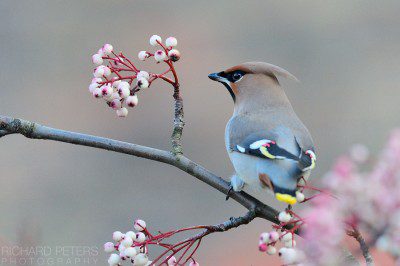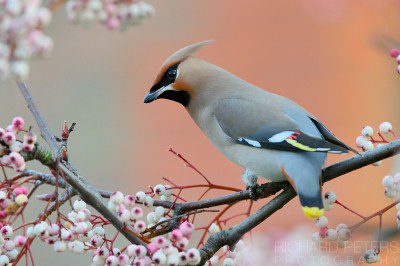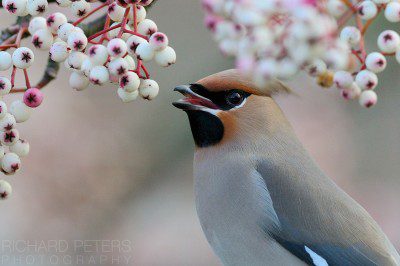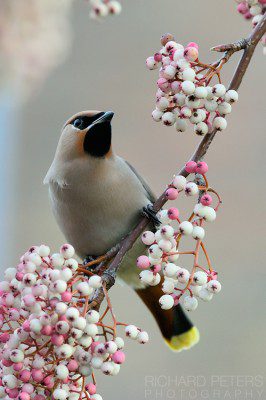On a cold Sunday morning in the middle of January, a few years ago, I found myself standing at a bus stop opposite a parade of shops in suburban West London. Not to catch the bus though. Instead, bizarrely, to photograph some feathered visitors from Scandinavia for the first time. Waxwings. A bus stop isn’t the most natural of settings or the most obvious of hides, granted, but since when has wildlife photography played by the book!

The most unusual of hides…
I heard about these birds on a Tuesday. Waxwings had been spotted very close to home, seconds from a train station in the front garden of a house, next to a bus stop and opposite a parade of shops. Hmmm. ‘No way that’s going to produce any photo opportunities’ I thought to myself. I ignored the info. A few days later, I heard they were still there and again, ignored it. The thought of standing on street full of pedestrians, with a big camera just didn’t register in my head as being conducive with taking wildlife photos. But then, on the Saturday night, after friend and fellow photographer Luke Massey sent me some photos he’d seen on Twitter, curiosity got the better of me. With my lack of luck with these birds (I’d recently driven an unsuccessful 150 mile round trip to try and photograph some) I figured they’d be gone but decided to head down the next morning. It’s only 20 minutes from where I live and I figured if they weren’t there, I’d be home by 9:30 for breakfast.
WAXWINGS!
As I sat de-icing my car I did still have some doubt, wondering why I wasn’t still in bed. But not 20 minutes later as I parked the car up and walked up the street towards the station, I saw a photographer aiming his camera in to the tree’s. A good sign. And I was right. He’d spotted them once already before I arrived and it was only a matter of time before they’d be back! And so there I was, in the most unlikely of locations. Yards from a West London train station (those of you local will know which one) with several other photographers and birders who turned up throughout the morning, with clear sight of waxwings! Given the birds proximity to the station, Luke caught the train in from Hertfordshire and I also saw a couple of other familiar faces.

Nikon D4, 200-400, 1/800, f4, ISO 3600
So from 9am, there we sat, waiting for the small flock of 9 or so waxwings to fly across from the far side of the train tracks to the Hubei Rowan tree in a front garden next to the bus stop. The birds would then spend anywhere from 30 seconds to a minute frantically eating before getting chased away by a resident mistle thrush, back to their safe haven far across the tracks. They’d perch there for 20 to 30 minutes, then fly back across to us again for 30 seconds or so.
TRICKY, FRUSTRATING BUT FUN!
I’ll be honest, my original fear of it being tricky for successful images wasn’t entirely far off as on paper, nothing about the opportunity was geared towards wildlife photography. The pavement was narrow meaning as the morning wore on more and more pedestrians would walk past on the way to the train station or sit at the bus stop. And of course, the tree was in a garden with a house for a background. Brick walls and white PVC window frames do not make for the best out of focus back drops so picking the birds out with a clear line of sight through the branches and with a clean background was frustratingly tricky. Even more so with those limited windows of opportunity. It was certainly a good test of reactions trying to pick the birds out as they hoped between branches and momentarily in and out of relatively clean background positions!

Nikon D4, 200-400 at 380mm, 1/640, f4.5, ISO 1800
I opted to stick with the D4 this time round, leaving the D800 in the bag. The light wasn’t ideal and because I needed to keep the shutter speeds up to freeze the rarely stationary birds, I knew the ISO levels would be quite high at times. The aperture virtually never moved from f4 in an attempt to keep the distracting backgrounds as diffused as possible. Added to that, with the birds moving around so quickly, a knew the higher frame rates would come in handy to try and catch the waxwings eating berries, although I never managed it with a good background. The only let down, was the 200-400, which doesn’t have the fastest of auto focus and struggled with the lack of light and speed of the birds at times. The 600 would have performed much better, but in this situation a tripod would have been useless as I needed to be mobile to follow the birds around the tree as best I could.
A GREAT MORNING
It may have been tricky and frustrating at times, but what made up for all those obstacles and ultimately turned a freezing cold pot luck morning in to an enjoyable experience was just how close the birds would come. It turned out the birds had been around for two weeks by the time I went to see them and so with some of the tree branches all but overhanging the pavement and with so many people about, the birds were far from shy. I’d say we were maybe six feet from them at times. Having such intimate views was incredible and having the opportunity to try and get a photo out of it was almost secondary.

Nikon D4, 200-400, 1/640, f4, ISO 2000
I only managed to get a small handful of clean-ish shots without major distraction but ultimately, despite being a slightly unusual place to find myself camera in hand, I’m glad I made the effort as it was certainly an experience. And at the end of the day, making the most out of any given opportunity is what it’s all about!

Nikon D4, 200-400, 1/640, f4.5, ISO 1800








